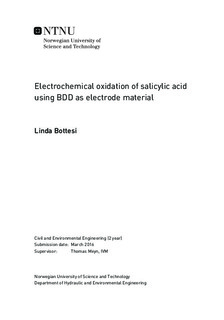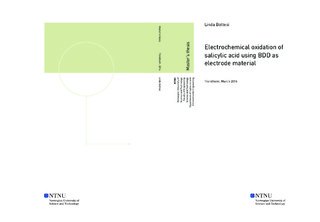| dc.description.abstract | The major project of the SHMIL landfill's leachate aims to find a complete treatment scheme, that leads to sty below the limits of the polluted compounds in Table before 2020.
The presented work is part of the initial phase and it focuses on an advanced oxidation process, which uses radicals to oxidize pollutants, in particular the organic matter. The process is called electrochemical oxidation and it uses electrodes, that generate radicals on the anode surface, which oxidize hazardous compounds.
The Chemical Oxygen Demand (COD) has not been reduced all by the same redox reactions, as some organic substances are more persistent and must be treated with more advanced techniques.
Oxidation by radicals is the most efficient and fastest way that leads to the increament of BOD5/COD, meanwhile the concentration of the pollutants decreases, because the radicals react with both, biodegradable and non biodegradable organic matter. Furthermore, other studies prove a good removal ratio for heavy metals and ammonia nitrogen using electrochemical oxidation. This makes argue the treatment can reach good results for the application on the complex matrix of landfill leachate.
The treatment is challenging for a theoretical reason, because the specific aspect of the radical oxidation are not completely known and the technique are not developed enough to test it and also for a practical reason. The setup is new and finding the methodology to carry out an experiment requires a creative effort.
In the reported work, different configurations of the setup are analized. In the electrolytic cell, the electrodes are made of a cover of BDD (boron-doped diamond) on a silicon support. The evaluated aspects are the following: the electrolyte nature of NaCl and NaSO4, the concentration of it in the solution of 0,05 M and 0,1 M, the application of reversal mode or not, the applied current of 1 A, 3,5 A and 7 A, the pH of the solution between 3, 7 and 12 and the temperature of 13°C, 20°C and 27°C.\\
The collected data for every experiment are the temperature, the conductivity, the applied current, the voltage, the pH of the solution, the absorbance spectrum and the TOC concentration.\\
\\
The experiments carried out with NaCl demonstrate a higher removal rate compared to the ones with the other electrolyte. Moreover, the comparison between the different applied currents, indicates a better efficiency for the higher current. For the second round of experiments, it can be argue that at higher temperature, as well as higher pH, the absorbance value at the peak of 298 nm, decreases faster than the other configurations. The results of the TOC analysis, instead, depict the removal ratio is basically the same for all the configurations with a mild higher carbon concentration of the last sample for the experiments at 13°C. The final result of the carbon concentration together with the ones of the absorbance, prove the generation of the intermediates is influenced by the different parameters, but the final carbon concentration does not change. | |

